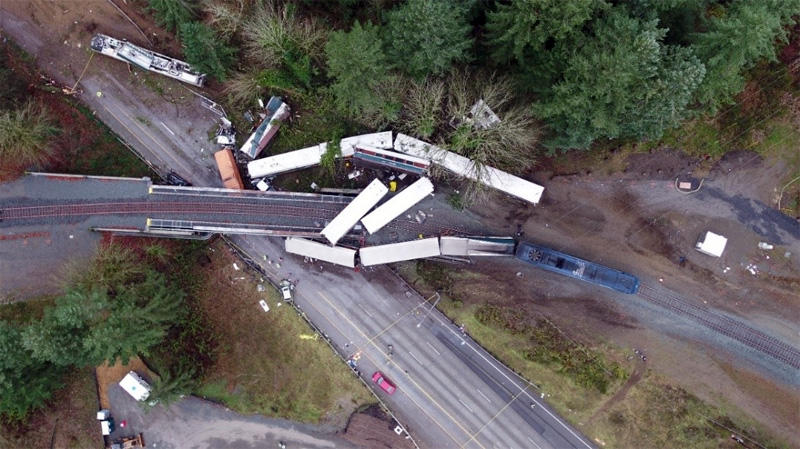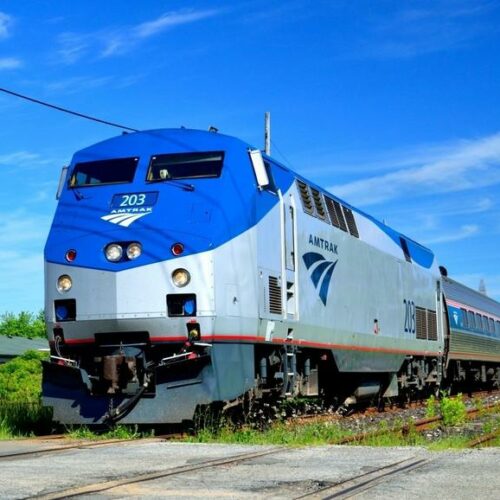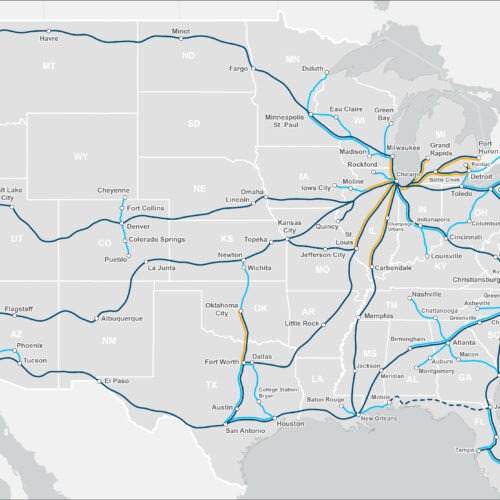
Testimony Points To Human Error As Cause Of Deadly Amtrak Derailment In DuPont
Listen
Federal investigators have interviewed the engineer who was at the controls of Amtrak Cascades Train 501 that derailed last month south of Tacoma. The interview summary points more strongly to human error as the cause of the deadly wreck.
The locomotive engineer told investigators from the National Transportation Safety Board that he knew a sharp curve was coming up, but as filtered through the NTSB, he said he “didn’t recall” seeing the advance speed limit sign.
The first of such warning signs is posted two miles before the curve in question.
When the engineer recognized looming danger, he testified he applied the brakes. But by then it was too late, just seconds before the speeding train launched off an overpass and crashed onto adjacent Interstate 5.
The train entered the 30 mph curve traveling 78 mph according the data recorder retrieved from the lead locomotive.
The derailment killed three passengers and injured more than 60 of those onboard along with an eight motorists whose vehicles crashed into derailed train carriages.
Numerous injured passengers and a driver on the freeway have since sued Amtrak. They allege inadequate crew training and negligence in not activating automatic speed control technology on the line.
On the topic of training, the unnamed locomotive engineer said he would not have gotten behind the throttle if he had any reservations about his readiness to operate the train on the new, higher speed routing alongside I-5.
The 55-year-old engineer suffered serious injuries in the wreck on December 18. His interview with federal crash investigators didn’t take place until last week.
“In the five weeks preceding the derailment, the engineer had qualified on the Point Defiance Bypass section of track following the completion of seven to 10 observational trips in the locomotive as well as three trips operating the equipment, two northbound and one southbound,” said the NTSB investigative update released Thursday.
The union representing the engineer, the Brotherhood of Locomotive Engineers and Trainmen, said it could not comment on the NTSB’s account of the interview because the union is a party to the ongoing investigation.
The engineer also said he was not distracted by a conductor-in-training who was riding with him in the cab during Amtrak’s inaugural run with paying passengers from Seattle to Portland using the Point Defiance Bypass.
The NTSB investigators interviewed that conductor, Garrick Freeman, last week as well. Freeman corroborated the engineer’s statement that he was rested when he began his shift.
“He (Freeman) told investigators that the engineer appeared alert during the job briefing and while operating the train,” the NTSB wrote in its update Thursday. Freeman has also sued Amtrak for negligence and is seeking unspecified damages.
The NTSB reiterated that its full investigation will take 12-24 months to complete.
Related Stories:

Pandemic-Curtailed Amtrak Service To Be Partially Restored Next Month For Northwest Routes
In another sign of the rebound in travel, Amtrak and the state transportation departments of Oregon and Washington announced plans to restore a good chunk of the passenger train service that was curtailed due to low ridership in the pandemic.

As President Biden Pushes Major Rail Investments, Amtrak’s Proposed 2035 Map Has People Talking
When President Biden unveiled his major new infrastructure plan last week, the proposal included much more than fixing crumbling bridges. And for those who wish America had a more robust passenger train network, it gave them something new: hope.

‘I Knew I Needed To Go Out,’ Says Blood Donor Marking 3rd Anniversary Of Deadly I-5 Amtrak Crash
Three years ago on December 18, a speeding Amtrak Cascades train bound for Portland derailed near DuPont, Washington, and tumbled onto Interstate 5. The crash killed three passengers and injured scores of others. An Olympia woman marked the anniversary Friday by going back to her local blood donation center to achieve a related, but happier milestone.















